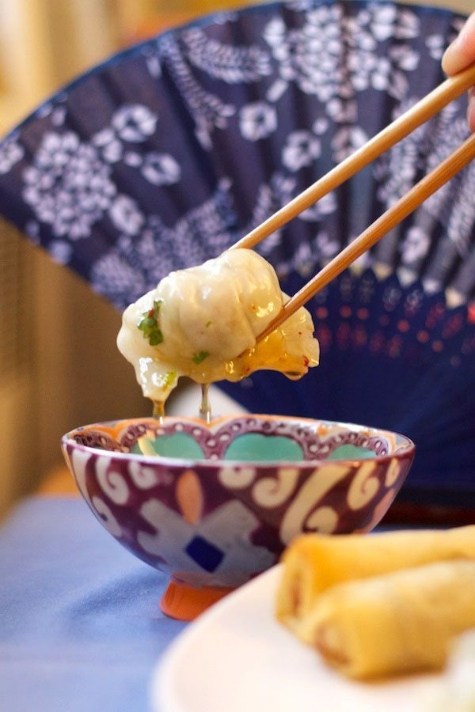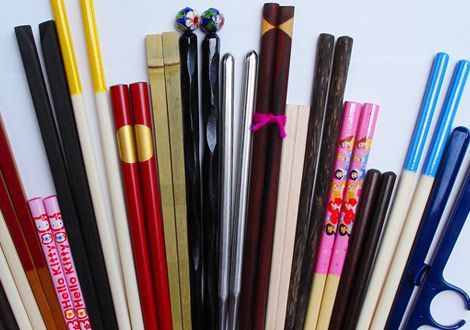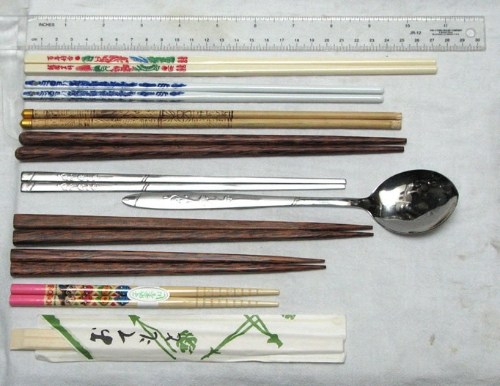
Raise your hand if you know how to use chopsticks! Do you like them?
Just as I can’t remember first feeding myself with a fork or spoon, I can’t remember a time when I didn’t use chopsticks. When it came to eating, I was a quick and early learner. 🙂 I do remember loving a special pair of children’s chopsticks I once had — they were pink plastic with black and gold specks. Naturally, they made everything taste better.

Back in the dark ages when I was doing school visits for Dumpling Soup, I always brought wooden chopsticks along. The majority of first graders had never used them before, and they had fun trying to pick up M&Ms, Cheerios, and gummy bears. Some were so pleased with their newfound skill that later in the cafeteria they even tried to eat their lunches with them. Ever try to pick up half a PB&J sandwich with chopsticks? 🙂
Too bad I didn’t have David Booth’s poem to share with them then.

RHYMING CHOPSTICKS
by David BoothI am having a meal
With Bernard, my best friend,
When I notice the chopsticks
That I can’t comprehend.Can I manage this dinner
Without fork or spoon?
These tools are confusing —
I’ll be a buffoon!I can handle cloth napkins
Tucked under my chin,
But two plastic chopsticks?
My worries begin.I don’t know the tricks,
My fingers are numb.
Bernard whispers to me,
“Don’t look so glum.”“Hold one stick in place,
Just move the next one.
Now rest it against
The base of your thumb.”I watch every move,
and listen to clicks
as all of these diners
flick their chopsticks.I spear a fat dumpling
Like a fish in the sea.
Then another big one
Until I have three.His mother then says,
“Try some of these noodles.”
I stare at the platter
With oodles of noodles.Somehow I nudge some
Onto my plate,
And then begin twirling —
The sticks hold my fate.But the best I can do
With my mouth open wide
Is to slurp them and suck them
And drag them inside . . .Wait just a minute!
I’m catching on fast!
I’m twirling my chopsticks . . .
I’ve got it at last!Smiles all around,
I’m ready to dine
With cutlery new,
Any old time.Chopsticks rule!
~ from Head to Toe Spaghetti and Other Tasty Poems (Rubicon, 2015). All rights reserved.
* * *

Did you know that using chopsticks involves over 30 joints and 50 muscles in the fingers, wrist, arm and shoulder as well as thousands of nerves? Quite a feat of coordination, so don’t feel too badly if you haven’t quite gotten the knack yet!

Of course we have the Chinese to thank for inventing chopsticks about 5 – 6000 years ago; these were long sticks initially used for cooking and later Confucius influenced their development as an eating utensil with his philosophy of nonviolence (implements like knives associated with warfare have no place at the table).

Chopsticks are now most commonly made from wood, bamboo, plastic, and stainless steel, though ivory, gold, silver, porcelain and jade have also been used. Chances are good that if you like to eat out, you’ve probably encountered these three main chopstick types:
Chinese chopsticks (melamine plastic or wood) are longer (9″) with squared or rounded sides and usually blunt, flat (sometimes pointed) ends;
Korean chopsticks are shorter, often metallic with blunt ends;
and Japanese chopsticks are usually made of lacquered wood and tapered with sharp, pointy ends (esp. good for picking out fish bones!). While Chinese chopsticks are typically unisex, in Japan chopsticks come in different sizes for men, women, and children, and they are often more elaborately decorated.

What kind of chopsticks do you have in your flatware drawer? Most of ours are Japanese. 🙂
Speaking of eating out, Janet Wong’s wonderful poem brought back pleasant memories of the many, many times we ate at Chinese restaurants back home in Hawai’i. From small hole-in-the wall dives to shopping center food courts, to bustling dim sum places in Chinatown, to fancier Waikiki restaurants for wedding receptions, our trusty chopsticks served and fed us well. When I was little, it was fun to see what tasty tidbit would magically appear on my plate, lovingly fetched by my mother from the lazy susan in the center of the table.

GRANDFATHER’S CHOPSTICKS
by Janet WongGrandfather’s chopsticks
are like extra-long
superhero fingers,
able to grab anything
on the big round
restaurant table.He picks up
a piece of my favorite
honey walnut shrimp
and puts it on my plate.
Slippery noodles.
Fried chicken —
crispy skin
and tender white meat.Grandfather’s chopsticks
are pretty smart:
how do they know
exactly
what I want to eat?~ from The Poetry Friday Anthology, K-5 Edition (Pomelo Books, 2012). All rights reserved.
*

Don’t tell me. You’re really hungry now, right? Wouldn’t you love some mixed vegetables chow fun or cashew chicken? When it comes to these foods, chopsticks is the only way to go. Best to brush up your chopsticks etiquette for your next meal. 🙂
- When using disposable wooden chopsticks (waribashi) in restaurants, it is insulting to the host to rub them together since you’re implying they have splinters and are cheaply made.
- Do not tap your chopsticks on the edge of your plate or bowl; this is a common practice beggars use to get attention.
- Don’t point rested chopsticks to others seated at the table.
- It is considered rude to spear one’s food, suck on your chopsticks, go digging for a particular piece of food in a plate or bowl, or to dip individual chopsticks into a communal bowl.
- Even if you’re in a good mood, DO NOT use chopsticks as drumsticks, wave them around when you’re talking, or stick them in your ears or nose. And for heaven’s sake, don’t rinse your chopsticks in your soup or let soup or gravy drip from your chopsticks.
- When at rest, chopsticks should not be crossed (symbol of death), placed in a “V” position (bad omen), or left sticking straight up in a bowl of rice (resembles the practice of offering food to the spirit of a dead person, at a funeral or an altar).
- Placing chopsticks together on the top of your bowl indicates you are finished, to the side of the bowl or on a chopstick rest means you’re taking a break from eating. Resting chopsticks should be placed with tips pointing to the left.
- Passing food chopstick to chopstick is bad form as it resembles the Buddhist ritual of removing cremated bone fragments from the pyre and passing it among mourners.
*Interesting side notes: An old Korean superstition states that the closer to the tips one holds his/her chopsticks, the longer he/she will remain unmarried; the fear of chopsticks is called “Consecotaleophobia.”


Fascinating pair of sticks aren’t they?
A final tip about eating from a rice bowl for the truly refined: Generally, the Chinese hold their rice bowls in one hand and use their chopsticks to push rice into their mouths, while the Japanese pick rice up with their chopsticks, using the bowl to catch any drips. In Korea, chopsticks are used for solid side dishes, and rice is eaten with a spoon.
Now you’re all set! Feast and be merry! Chop chop!
* * *
 Beautiful Buffy Silverman is hosting today’s Roundup at Buffy’s Blog. Sashay on over and check out the full menu of delectable poetics posted around the blogosphere this week. Happy December! Just 21 days till Christmas! Yikes! *runs away screaming*
Beautiful Buffy Silverman is hosting today’s Roundup at Buffy’s Blog. Sashay on over and check out the full menu of delectable poetics posted around the blogosphere this week. Happy December! Just 21 days till Christmas! Yikes! *runs away screaming*
*
![]() This post is also being linked to Beth Fish Read’s Weekend Cooking, where all are invited to share their food-related posts. Rustle up your chopsticks and come join the fun!
This post is also being linked to Beth Fish Read’s Weekend Cooking, where all are invited to share their food-related posts. Rustle up your chopsticks and come join the fun!
—————————————————–
Copyright © 2015 Jama Rattigan of Jama’s Alphabet Soup. All rights reserved.

Loved this! 🙂 I, too, can’t remember a time I didn’t eat with chopsticks. The other day, at a restaurant, a patron had her chopsticks sticking straight out of her bowl of rice. ACK! It was so hard for me not to correct her. I had to turn away. 😉 Side note: I use chopsticks with my left hand, and fork and spoon with my right.
LikeLike
Oh, a leftie! I think my brother does the same thing though he does other things with his right hand. I *did* read somewhere that it’s proper to use chopsticks with the right hand, even if you’re left-handed. 🙂 So you’re a rebel!
LikeLike
I will admit that I was part of the “stab-‘n-stuff” crowd until I finally learned how to use chopsticks “properly” at age 12 or so. I just now realized that this was partly caused by my mother and grandparents always putting food on my plate instead of requiring me to fetch it by myself from the dishes in the center of the table. My mother says I still don’t use them really correctly, but I think I do! And I remember sticking them in rice like ski poles in snow–and being corrected. My Chinese grandfather told me that the teacher in his village school used chopsticks to whack kids on the knuckles–really hard (sounds like it really hurt, too). Loved this unexpected piece on chopsticks today, Jama!
LikeLike
That does sound like a painful punishment! Similar to the ruler or yardstick some teachers have used.
Surprised that you were 12 before learning to use chopsticks properly. Even kids who know how to use chopsticks find it hard to reach those dishes in the center of the table. Thank goodness for helpful parents and grandparents. 🙂
LikeLike
I like eating with chopsticks, but the list of no-nos left me a bit overwhelmed. Yikes!
LikeLike
Some of the no-no’s are obvious, while others are hard to remember. If you’re sitting at a round table, it would be tricky to make sure your resting chopsticks weren’t pointing to anyone.
LikeLike
I had no idea there were so many rules, so now when I eat with chopsticks, I will try to remember them, at least the ones about leaving in the bowl and pointing to a person, Jama. I’ve eaten with chopsticks really only at different restaurants, and “think” I have the hang of it. I also didn’t know there were different ones from different cultures. The poems are sweet capturing of memories, aren’t they? Thanks for all!
LikeLike
It’s fascinating all the different types of chopsticks from different cultures. We naturally grew up mostly with Japanese lacquered chopsticks, and I never saw the Korean stainless steel ones except in restaurants. And I only use the long plastic blunt edged ones when we go out for Chinese food. I do have an extra long wooden pair for cooking. 🙂
LikeLike
Hi, Jama, what a fascinating post! I had no idea there was so much variety and history and lore about chopsticks! And of course I love the poem and food connections too. You always write the most interesting and entertaining posts! Thanks so much for all your work.
LikeLike
Thanks, Sylvia. Glad you enjoyed learning a bit more about chopsticks. I do think they make certain foods taste better. 🙂
LikeLike
Fascinating! I knew a few of the rules, but certainly not all of them. I am now going to examine the different chopsticks sets accumulated in our travels. I knew they were different at the time, but it’s been years and I can’t remember where I got them.
LikeLike
That’s cool that you have different chopsticks from the different places you’ve visited. I’d love to see some of the less common ones in person. Also only recently learned about the common misconception that chopsticks are ubiquitous in Thailand — apparently the knife and fork are standard, and chopsticks are only used in certain restaurants.
LikeLike
Wowza. This was fascinating! I love eating with chopsticks, and when we order Chinese, it doesn’t taste the same without them! But you know, I think it is now time to buy some of my own. These are delightful poems, and I adored learning the rules and history and about the different types of chopsticks too. Everything in the world is interesting and beautiful when it’s here at your place. Thank you! xo
LikeLike
So glad you enjoyed the post, Amy! Yes, you definitely need to get your own chopsticks — there are so many wonderful types to choose from. I like the kids’ styles best — too bad they’re too short for me.
LikeLike
This post made me hungry.
LikeLike
Only one thing to do — go out for Chinese! 🙂
LikeLike
Ditto! I’m hungry!
LikeLiked by 1 person
A big fat dumpling is calling your name . . .
LikeLike
What a fun post. My mouth is watering!
LikeLike
So is mine :). I must have some dumplings soon!
LikeLike
Jama, Thank you for adding to my cultural understanding of chopsticks. Alas, I’m certain I’ve violated some of the etiquette rules for using chopsticks. I’ll try to do better in the future. When I teach writing haiku in the schools, I take the four sided bamboo chopsticks with me and children use a pen to write their haiku on the chop sticks (one side for each line) and the fourth side is for their name. The children have fun sharing their poems this way. Your posts are always so illuminating. Thank you. Someday we should share a bowl of shrimp and walnut rice together (and include Mr. Cornelius too.)
LikeLike
I love that idea, Joy!! I can see why the students love writing their haiku on chopsticks. 🙂
I’m sure I’ve broken some of the chopsticks rules too. Reading them also made me realize how much of my chopsticks etiquette was naturally acquired through first hand experience (observing others) rather than having any one person teach them to me.
LikeLike
Ah, those babies! And the slightly smaller baby is wisely making like a baby bird and opening up for those noodles! Another quick learner!
I have more Japanese chopsticks than anything but the disposable sort, which… admittedly, I rudely rub together because they ARE cheap! *ahem* I will try not to do that in public, though. Or, maybe I’ll just bring my own. Having seen all these pictures I want MORE. Maybe rosewood sticks this time…
Why is everything on your blog an excuse for more shopping, Jama-j???? Hm???? 😉
LikeLike
Okay, looking at the picture AGAIN, I see the chick!!!! There is just way too much to love in that picture, and in the subsequent poetry.
LikeLike
I admit I’ve rubbed those disposable ones together too — because they DID have splinters and I didn’t want to cut my lip on them. Shopping, me encourage shopping?? What DO you mean? 😀
I loved that photo too when I saw it. Haven’t been able to trace the exact source — seems it’s been floating about on the web for awhile.
LikeLike
The old disposable ones from the 1970s were much more splintery than the ones that are made today, I think. I remember sanding them against each other for 15-20 strokes–yes, as if trying to start a fire! Nowadays too there are the “deluxe disposables” with the rounded edges. Am I sounding like a “disposable chopstick old-timer”?
LikeLike
I think you’re right. I’m not finding it necessary to even consider rubbing the disposables together these days. And those rounded ones are definitely of much better quality. 🙂
LikeLike
Wow interesting facts Jama. Great poems.
LikeLike
Thanks for visiting, Catherine!
LikeLike
I’ve learned so much here today, Jama! Thanks for the chopsticks manners 101 and the great poems. One reason I like eating with chopsticks is because it helps me to s-l-o-w–d-o-w-n. Aside from the fast food ones in the back of the drawer still in their wrappers, we have a pair of chinese, a pair of japanese, and two pair of Cornelius’ favorites from when the kids were young.
LikeLike
We have a big pile of the disposable ones in our drawer too. I sometimes use them to clean the dryer lint trap. 🙂
LikeLike
Wow! I had no idea there was so much to know about chopsticks. Thanks for enlightening us, Jama, and for the fun poems!
LikeLike
Thanks for stopping by, Catherine. 🙂
LikeLike
So much fun and fascinating info, Jama! I will never cross my chopsticks again. And phew….I’m happy not to have consecotaleophobia.
LikeLike
Me too!
LikeLike
I remember the first time using chopsticks in a restaurant in Chinatown, Boston, with no forks to be had. Not even for ready money. Now I always keep lots of chopsticks on hand, and my kids can all use them. 🙂 They are handy for all kinds of things. Love your post, as always. XOXO
LikeLike
Yes, they’re definitely handy for many different things. Glad to hear your whole family can use chopsticks!
LikeLiked by 1 person
We have fun with them. It’s easier to eat a salad with chopsticks than a fork, I find. 🙂
LikeLike
Oh no! I’ve broken all the rules! Thanks for all these fun facts, tips on etiquette, lovely poems, the mouth-watering food pics… I am craving dumplings.
LikeLike
I think we’ve all broken the rules at times :). I’m craving dumplings too!
LikeLike
I think I need a set of the children’s chopsticks as I’ve never quite got the hang of them. I had no idea there were so many different types but I will remember the rules for when I finally do get the hang of them.
LikeLike
It takes a little practice but it’s worth it. 🙂 I wonder if the children’s chopsticks might be too small for your hands, though. . .
LikeLike
Great post and fun poems. I learned to use chopsticks early on, but really got the hang of them when I lived in Hawaii. I need to practice up again.
LikeLike
It’s practically a given that you can use chopsticks in Hawaii. Yes, do practice again! 🙂
LikeLike
When we were in NYC for Thanksgiving, we went to a Chinese restaurant. My oldest son used chopsticks, the rest of us didn’t. Most of us tried, but gave up. I’ve tried for years to use them, but just can’t get it.
Love the poems and all the different types of chopsticks.
LikeLike
Sorry to hear of your frustration trying to use chopsticks. It does require some practice. Kudos to your son!
LikeLike
Time for another try, I guess! I like the good fortune training ones. Do you think 66 is a little old for them, though? I was thinking about all the different materials you listed, and it brought me back to the time I learned crocheting using my grandmother’s hooks. I hated the metal ones (sort of set my teeth on edge), found the plastic uncomfortable, but the old wooden hooks were so nice. Maybe if I tried wooden chopsticks I’d have a better success rate? (I’ve become more conscious of sensory likes and dislikes as I’ve gotten older.)
LikeLike
Hmmm, I think the training chopsticks might be too small for your hands. But you should definitely try some wooden ones. After all, how can you effectively RANDOM NOODLE without chopsticks? The women on your blog header want you to try again. 🙂
LikeLike
I was in my 20’s before I first used chopsticks – but now I prefer them for many dishes. Cheers
LikeLike
Good for you!
LikeLike
I definitely need a pair of Hello Kitty chopsticks! How fascinating to know that there are so many types, and also so many rules.
LikeLike
One could easily be tempted to collect all the different kinds of chopsticks. 🙂
LikeLike
Love, love. love this piece on chopsticks! We have Japanese lacquered and Korean metallic chopsticks. I always had a hard time until we lived in Japan for a few months. Using them three times a day helped me catch on! There’s so much etiquette to learn – I only knew a little of your list. I’ve seen Japanese dip into a communal serving dish with the handles of their chopsticks to get around using the eating tips! Now I am so hungry. I know I’ll be making Japanese food this coming week! Thanks for sharing the chopstick poems!
LikeLike
Glad you enjoyed the post, Joyce. I’m impressed that you have both Japanese and Korean chopsticks! We never had the metallic ones at home growing up and I don’t have any now. I should do something about that!
We also turned our chopsticks around to pick up food from communal dishes. Enjoy your Japanese food this coming week!
LikeLike
Thanks for the chopstick etiquette. I love the richness we humans create around the most basic of our needs — not just the utensils (their shapes and sizes and materials), but also the “rules.”
LikeLike
Yes, me too!
LikeLike
What a fabulous lesson on the history and proper etiquette of chopsticks!
I remember when I finally mastered the chopstick technique. We had moved to NYC and I was considered the “outcast” at the table because I used a fork 🙂 I now love using them.
LikeLike
Yay for you!
LikeLike
Thank you Jama for this fascinating chopstick lore and etiquette. I will never look at chopsticks the same way again. And now I know why I have such trouble using them. It’s because, as you point out, their smooth operation takes the cooperation of many parts and I am uncoordinated!
LikeLike
Sounds like you need more practice. Trying to eat your favorite dish with chopsticks is the best incentive!
LikeLiked by 1 person
Echoing the word that’s been used here again and again – fascinating! Who knew all this history, lore, and etiquette? You and Mr. Cornelius. And now, we do too! :0)
Thanks for sharing it all, including Janet’s poem, which (even though I’m a vegetarian) I’ve always loved.
LikeLike
Chopsticks are especially good for eating stir fried veggies :).
LikeLike
I had no idea that the different cultures had different styles of chopsticks! Very cool. I’m … ok with chopsticks, although I usually do have to resort to a fork or spoon eventually, once the rice gets sauce on it and falls apart. (If rice stays in a separate bowl, I can usually manage.)
LikeLike
Tricky sauce on rice. Yes, me too. Need a spoon for that :)!
LikeLike
“The fear of chopsticks is called “Consecotaleophobia.” – now I know (and have?) a new phobia! What a fascinating post on chopsticks, Jama. I love the line in Booth’s poem, “Is to slurp them and suck them
And drag them inside . . .” I kind of do this when I eat noodles with chopsticks. =)
LikeLike
Sorry to hear about your new phobia. I hear a good serving of dumplings could cure that. 🙂
LikeLike
I manage to feed myself with chopsticks, but I wouldn’t say I’ve ever mastered them. I kind of want those “training” chopsticks!
LikeLike
They should make training chopsticks in an adult size. 🙂
LikeLike
Thanks for sharing the chopsticks poetry and etiquette, Jama!
LikeLike
You’re very welcome. Thanks for visiting, Becky!
LikeLike
Dear Jama! Who knew? I just ate with Korean chopsticks without knowing it!
I have favorite Japanese chopsticks from childhood that I still use–which I didn’t know were specifically Japanese.
Gotta run but just know that this post knocked it out of the park.
xox
LikeLike
Hooray for your Korean and Japanese chopsticks! You’re practically an expert. Thanks for reading. Glad you enjoyed the post, April! 🙂
LikeLike